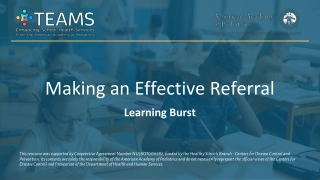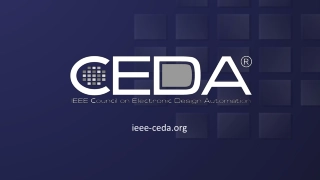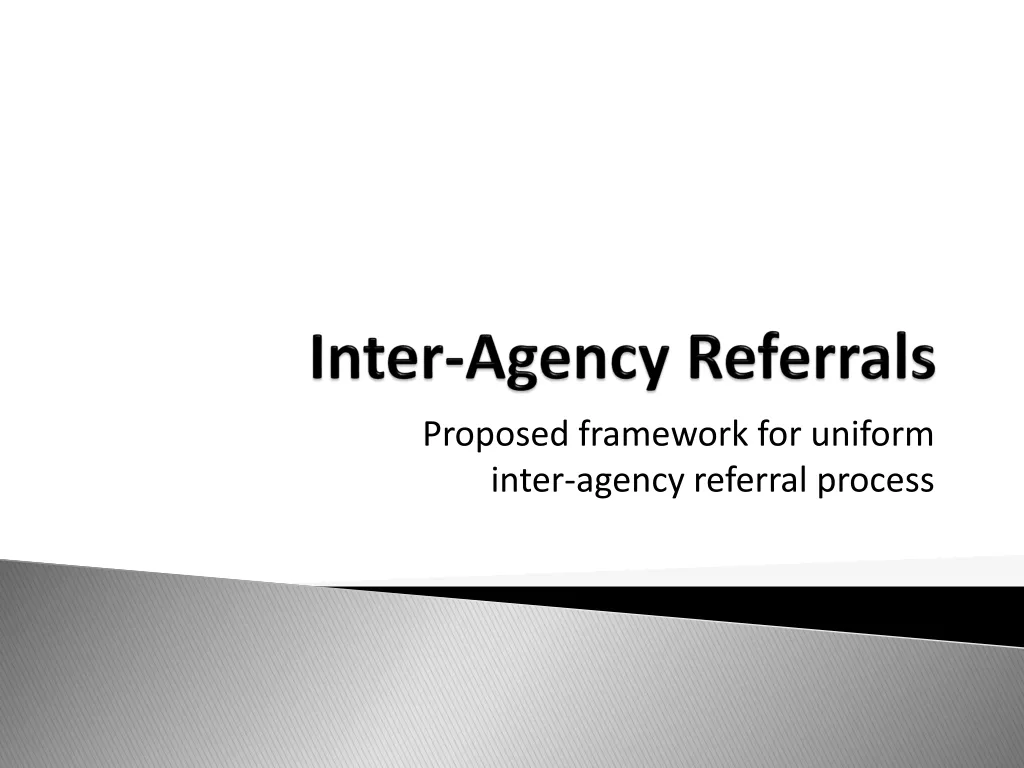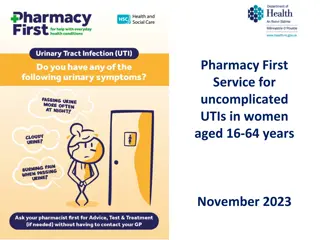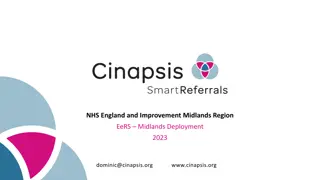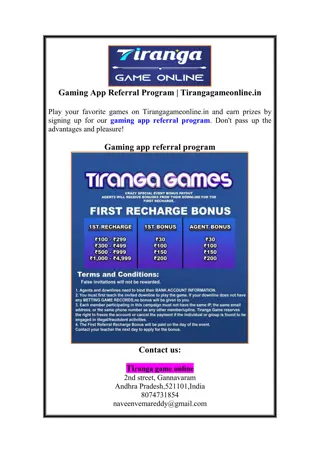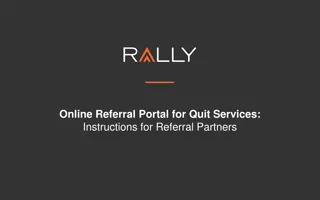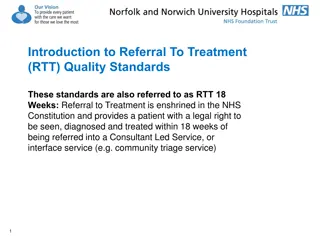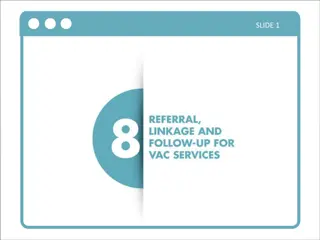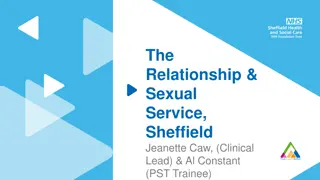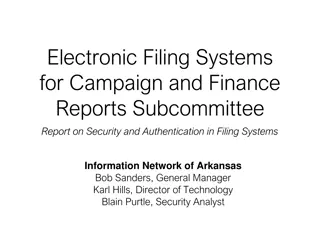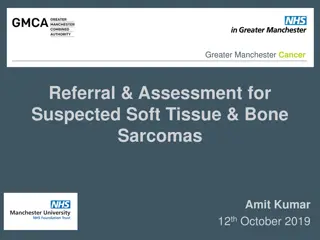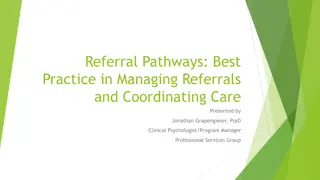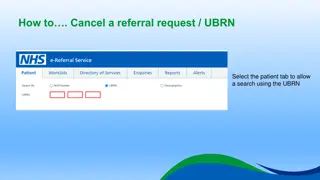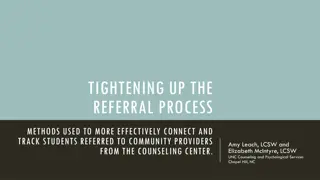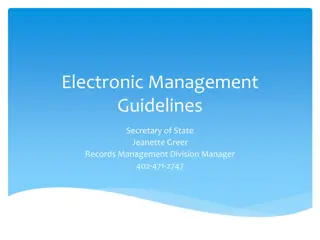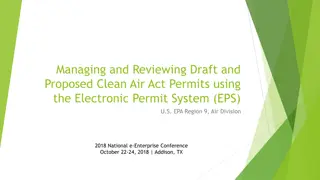
Evidence-Based Strategies for Tobacco Control and Treatment Referral
Learn about evidence-based strategies for tobacco control, including increasing tobacco prices, implementing smoking bans, and offering telephone counseling support. Discover the importance of provider reminder systems and the effectiveness of brief advice in tobacco cessation. Explore in-office cessation interventions and the role of electronic referrals in improving population health.
Download Presentation

Please find below an Image/Link to download the presentation.
The content on the website is provided AS IS for your information and personal use only. It may not be sold, licensed, or shared on other websites without obtaining consent from the author. If you encounter any issues during the download, it is possible that the publisher has removed the file from their server.
You are allowed to download the files provided on this website for personal or commercial use, subject to the condition that they are used lawfully. All files are the property of their respective owners.
The content on the website is provided AS IS for your information and personal use only. It may not be sold, licensed, or shared on other websites without obtaining consent from the author.
E N D
Presentation Transcript
Electronic Referral Electronic Referral for Tobacco Using Patients Scott McIntosh, PhD Center for a Tobacco-Free Finger Lakes University of Rochester School of Medicine & Dentistry Department of Public Health Sciences
Evidence-based Strategies in Tobacco Control Increases price of tobacco Clean Indoor Air (Smoking bans & restrictions, policies) Mass Media campaigns with interventions (i.e., part of comprehensive tobacco control programs) Reducing patient costs for treatment Availability of treatment for tobacco dependence Provider reminder systems Telephone counseling and support Source: Guide to Community Preventive Services, Systematic Reviews & recommendations
Evidence-based Treatment Goals 70%want to quit. Very Brief Advice 1 to 3 minutes is EFFECTIVE (40% increase) Clinician advice alone is EFFECTIVE More counseling is even more effective e.g., 30 minutes can be 90% increase SO: Time spent at point of care - PLUS - Multiple providers - PLUS - Telephone Quitline Counselors 7%achieve long-term abstinence on their own. With physician assistance - every patient, every visit - this increases to > 30%. 3
In-Office Cessation Interventions At all patient / client contacts Ask whether client smokes Advise client to stop Assess whether client wants to take action Assist client in developing plan Arrange follow-up 4
Introduction to Center For a Tobacco-Free Finger Lakes Center For A Tobacco-Free Finger Lakes (formerly GRATCC) uses evidence-based resources and programs to assist organizations in the design and implementation of policy and office based systems to identify and effectively treat tobacco dependence, according to the Department of Health and Human Services Clinical Practice Guidelines. Electronic Referral from large medical and mental health systems is a primary goal with a large anticipated impact on Population Health
Ideal Quitline e-Referral Example Source: http://www.naquitline.org NAQC. (2013). Quitline Referral Systems. (A. Wendling, MD, MPH and R. Daigh, MBA). Phoenix, AZ.
Steps Taken So Far STEPS TAKEN SO FAR - Comprehensive policy (established 2013) - Recommended Minimal Data Set for EHR - State subcommittee (Disseminated Feb, 2014) - Refer to Quit - Electronic referral capability established, Summer, 2017 - Opt to Quit (ultimate goal, identified in SMH Policy) - Inpatient vs. Outpatient / Ambulatory - Health Maintenance Navigator for Outpatients - Social History - Clinician training toolkit and materials (CTFFL website, 2017)
Three Areas or Silos that need to be collaborators Technical Financial Medical Directors/Clinicians Chief Medical Officers Clinical Staff Quality Assurance Officer Chief Information Officers Policy Teams Financial backing Funding resources Who will pay for build? Engineers EMR Builders Implementation Teams Security/HIPPA Training EMR Vendor Clinical Informatics
Justification Medical Directors and clinicians have to be involved from the top down to justify a new build (software programming in EPIC). E-referral must make clinician s job easier not harder. New EMR builds have to benefit the medical system financially. A strong case needs to be made for why the build is beneficial for reducing hospital admissions, saving on health care costs, etc.
Physicians identify implementation challenges Eliminate the number of clicks. It s too many ..Compare that to going on Amazon. In three clicks I have bought a book (Local Physician) 1. 2. 3. 4. 5. 6. Unexpected costs to implement the basic system 7. Concern of system quality 8. Concern with vendor quality and support 9. Unexpected costs to customize the system to a practice s needs and requirements 10. Unexpected costs to maintain the system and keep it function Excessive physician and staff time to implement Disruption to practice Concern with the time it will take to implement and be eligible for meaningful use Concern with staff skills and ability to implement Unexpected costs for associated hardware Source: Medical Economics EHR Best Practices Study October, 25 2017
Technical/Legal Concerns Concerns and questions at the institutional level HIPAA Will transmission of data violate any possible HIPPA rules? Data Transmission What pr0cess for transmitting data will be used? Data Security What security concerns or policies are in place from prospective client? Legal Health Care Providers are sometimes required to obtain a Business Associate Agreement (BAA) if a third party vendor is performing a function or service for a facility & Affiliates that requires the vendor to have access to health information to create, receive, maintain, or transmit protected health Information (PHI) in order to perform their functions.
Technology Acceptance Model Ronis S, Baldwin C, McConnochie K, McIntosh S, Szilagyi PG, Dolan JG (2015). Caregiver Preferences Regarding Personal Health Records (PHR) in the Management of Attention Deficit Hyperactivity Disorder (ADHD). Clinical Pediatrics, 54(8): 765-74. PMCID: PMC4474750. doi: 10.1177/0009922814565883. Davis FD, Bagozzi RP, Warshaw PR. User acceptance of computer technology: a comparison of two theoretical models. Management science 1989;35:982-1003. Venkatesh V, Davis FD. A theoretical extension of the technology acceptance model: four longitudinal field studies. Management science 2000;46:186-204. Azjen I. The theory of planned behavior. Organizational Behavior and Human Decision Processes 1991;50:179-211.
Technology Acceptance Model What are the decision-making variables representing the pros and cons of changing at the Institutional level? Pre-Contemplation/Contemplation Preparation Action/Maintenance As we do with patients in pre-contemplation, we aid the institutional decision-making process with education, meeting them where they are at, finding their motivation, making it easy for behavior change.
Assessing Actual Use Ongoing evaluation of actual use is vital to decision making, development, implementation, and improvements. Have you used eRecord for your patients who use tobacco? Which of the referral order features have you used? What is the main way you access referral orders? For offices/institutions: Are your clinicians aware/trained? How many use it? What documentation do you have?
Barriers Barriers If you (clinician) have not used electronic referral for tobacco users, what are the main reasons? If you (institution) have not created electronic referral for tobacco users, what are the main reasons?
Behavioral Intentions I intend to use electronic referral more frequently in the future
Perceived Usefulness Process Management Record Keeping process management (7b-f, 8, 9f, 10) record keeping 7a, 9a-e) I find the electronic referral easy to use For each of the following features, please indicate how useful you think it might be . for treating patients Nicotine Dependence for prevention of CVD, Caner, other diseases for caring for your patients in general
External Variables Work Flows Record Keeping When you have concerns about patient tobacco use, how do you proceed in your setting (what is the workflow)? How often do you get the specific information you need? How easy are referrals using your EHR?
Barriers Policy Cost Barriers If you (institution) have not created electronic referral for tobacco users, what are the main reasons? _ Not a priority _ Not reimbursed _ No policy _ Patients do not want this _ Programming cost _ Legal barriers _ It s up to the patients
Barriers ADDRESSING INSITUTIONAL BARRIERS _ Not a priority _ Not reimbursed _ No policy _ Patients do not want this 70% of patients expect/rapport is increased _ Programming cost Other diseases lack outside funding _ Legal barriers Business Partner Agreement _ It s up to the patients No. Addiction is a Chronic Disease As patients in pre-contemplation, we aid the institutional decision-making process with education, meeting them where they are at, finding their motivation, making it easy for behavior change. Joint Commission, CVD, DSRIP Increasingly being reimbursed Policy 10.03 since 2013
Where We Are At Where we are at: Policy in place, and it is clear: address with each patient, every visit, use Opt-to-Quit, etc. Legal barriers addressed (BPA, HIPAA) Programming finished for basic referral to the Quitline Disposition data workflow still in development, reliant on CTFFL funding for consultant to receive and report on patient outcomes One announcement by PR department Uptake still similar to baseline (i.e., same champions are using electronic referral, need to expand adoptors)
Lessons Learned Lessons Learned CTFFL and CCH facilitated progress Policy, high level buy-in, initial programming Each mid-level system at their own Stage of Change Necessitates multiple engagement, education, movitvation Overall progress only as strong as weakest link Clinical Counsel, Programmers, PR, Uptake still similar to baseline (i.e., same champions are using electronic referral, need to expand adopters) The evidence-base and data do not reliably influence decision- making. Why not? Public Health isn t real science or real medicine It s patient behavior not addiction There are too many other, more important, priorities
Next Steps Next steps Increase PR, messaging, etc. that the referral exists Keep working to make progress with disposition data Designate someone to take over from CTFFL Programming improvements to provide seamless data flow to and from the Quitline, and in-and-out of each patient s electronic health record (where evaluative data are all housed, including clinician behavior, tobacco use, related health variables, number of hospitalizations, co-morbidity, etc. Evaluation (REDCap survey, interviews) What else?
Expected Results Clinicians who have already used the electronic referral will be more likely to have favorable opinions about usefulness and functionality. They will also be more likely to report high intentions to use the referral in the future Anticipate low to moderate uptake of use, with steady increases over time per: PR buy-in, CTFFL messaging, word-of- mouth, and Data, Data, Data.
Additional Resources Online CME / treatment information www.nysmokefree.com (Click to Quit) www.smokefree.gov (includes chat) www.Talktoyourpatients.org (clinician resources) Treating Tobacco Dependence - Clinical Practice Guidelines www.surgeongeneral.gov Center for a Tobacco-Free Finger Lakes Training & Materials Website: www.smokingresearch.urmc.edu
Wrap Up Please fill out evaluation: http://j.mp/2Eddd1m Or: Thank you! For more information: Center for A Tobacco-Free Finger Lakes Scott McIntosh, PhD, Director email: scott_mcintosh@urmc.Rochester.edu phone: (585) 275-0511

